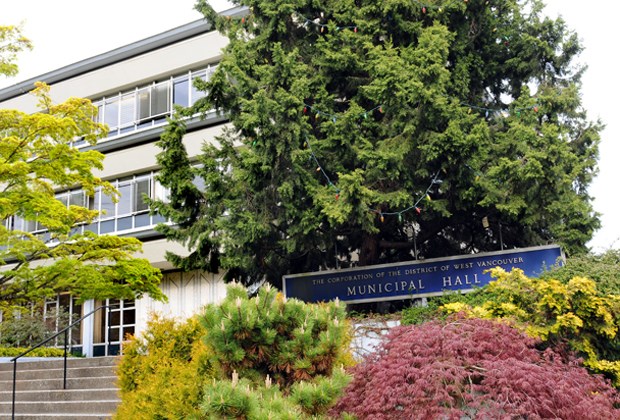The world has changed. It’s time West Vancouver changed with it.
That was Mayor Michael Smith’s message as council approved the Marine Drive local area plan Wednesday in a 4-3 vote.
“The world has changed everywhere but West Vancouver,” Smith said, approving a “roadmap” for three developments along a bow tie shaped swath of land along Marine Drive between Capilano Road and Park Royal.
The plan pencils in a tower between 24 and 26 storeys at 303 Marine Dr., two flat-iron style buildings between 12 and 14 storeys at the former White Spot site at 752 Marine Dr., and a six- to eight-storey project at 660 Clyde Ave. Each project will be subject to council approval.
As the tie-breaking vote, Smith emphasized two rights: the right of an owner to develop their property and housing as a human right.
“Housing is a basic human right and it’s been screwed around by, I think, mainly the senior levels of government,” he said.
Smith bashed B.C.’s tax code, which he suggested was 50 years out of date and responsible for allowing single-family homes to be gobbled up by investors rather than families.
The 303 Marine Dr. project is a “no brainer,” according to Smith, who suggested it complements the District of North Vancouver’s Lions Gate town centre plan, which is expected to comprise 1,200 units.
The Clyde Avenue development, which was initially pegged for a 15-storey tower, is now a “status quo” plan, according to Smith. The White Spot site is “an empty lot, doing nobody any good,” that can provide much needed housing and plenty of tax revenue, he said.
Council is being asked to make a decision based on an incomplete document, countered Coun. Christine Cassidy, who suggested three proposals had “morphed” into one plan.
“In my humble opinion … two of those sites are merely being included so that 752 (Marine Drive) will be passed,” she said.
The plan requires a “leap of faith” from council, pronounced Coun. Peter Lambur.
The plan fails to reflect community expectations, ease the development application review process or offer council “clear metrics” to make decisions, he argued. “I hate to see important things like these left to the vagaries of a negotiation process.”
Even if developers produce proposals that win council approval, residents won’t be moving into the new developments for five years, noted Coun. Nora Gambioli.
“During that time TransLink will have improved service,” she predicted.
However, Gambioli said she wouldn’t support any project unless the developer demonstrates: “real improvements in transit and infrastructure plans related to traffic.”
Gambioli’s words didn’t assuage Coun. Bill Soprovich’s concerns, who reminded council of the gridlock nightmare throughout the corridor.
The plan neglects to address “even short-term (traffic) solutions,” according to Soprovich. “I think there should be a transit hub somewhere on Park Royal’s leased land or on Squamish land,” he said.
Most of the shopping centre south of Marine Drive is on Squamish Nation land.
Council should have a master plan rather than making decisions a few kilometres at a time, Soprovich said. “We’ll have local area plan upon local area plan coming at us,” he predicted.
Many of the arguments against the plan amount to: “excuse-making to maintain the status quo,” argued Coun. Craig Cameron.
Cameron accused his colleagues of obstructionism, suggesting they were hinging their votes on “un-meetable” conditions related to traffic infrastructure. “People will continue to mouth platitudes about supporting things but when it comes up for a vote, they’ll keep voting against it,” he said.
Council’s moral, social, economic and environmental obligations made supporting the plan easy, according to Cameron. “I’m fully confident that the residential proposal for 752 Marine (Dr.) will not worsen the existing traffic situation and may, in the long run, improve it,” he said. “The days of breezing across the Lions Gate Bridge at all hours, alone in your Cadillac convertible with the top down, are over – if they ever existed.”
TransLink will not put more buses through Marine Drive unless the municipality densifies, Cameron said.
Cameron concluded his remarks by citing a proverb.
“Society grows great when old men plant trees whose shade they know they shall never sit in,” he said.
Coun. Mary-Ann Booth underlined the urgency of the housing affordability crisis, quoting former United Nations rapporteur on housing Miloon Kothari, who recently made headlines by suggesting Vancouver’s divide between rich and poor risked creating an apartheid city.
“West Vancouver is well on its way to becoming either a ghost town, where young people aren’t replacing the aging demographic, or a resort town where only rich, international buyers can afford to buy and leave houses vacant most of the year,” she said.
West Vancouver needs to build 2,000 housing units over the next decade, Booth said.
Moving forward, Booth said she wanted the development proposals to maximize the rental component, particularly for residents with disabilities on low incomes, minimize parking allocations, and include affordable child care. “There never is one silver bullet to solve complex problems, but doing nothing is guaranteed not to solve anything.”
West Vancouver needs to house more of their increasingly dispersed workforce, agreed Gambioli. “If not this site, where would we put all of this housing?” she asked. “And if not now, when?”



